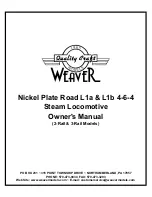
32
Hangar 9 Ultra Stick 40 ARF Assembly Manual
Step 5
Attach the engine mount rails to the firewall using four 8-32
x 1-inch socket head screws and four #8 washers. Use a 1/8-
inch hex wrench to tighten the screws. Leave them slightly
loose so the mount rails can be moved to fit your particular
engine.
Note
: Step 6 is only necessary if you are installing a
four-stroke engine. Skip to step 7 if you are installing a
two-stroke engine.
Step 6
Note the direction of the carburetor in relationship to the
engine. It may be necessary to rotate the carburetor on your
engine to match the photo.
Step 7
Position the engine between the engine mount rails. Use a felt-
tipped pen to mark the firewall where the throttle pushrod tube
will be positioned.
Step 8
Use a drill and 5/32-inch (4mm) drill bit to drill the firewall for
the throttle pushrod tube.
















































